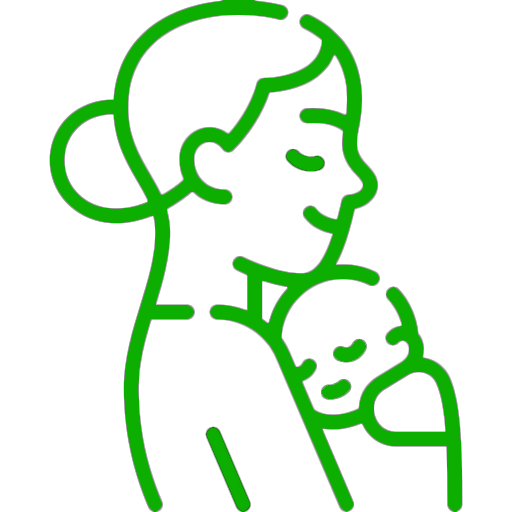One of the first things you discover after giving birth to your child is how much she weighs. This information assists the healthcare practitioner in assessing your child’s health and growth, particularly when weight is tracked over time. Continue reading to learn about the typical infant birth weight, average baby weight by month in the first year, and how your baby’s weight is tracked.

Average Baby Birth Weight
Average Baby Birth Weight
At delivery, full-term newborns normally weigh between 5 pounds 11 1/2 ounces and 8 pounds 5 3/4 ounces.
Within this range, 80% of full-term babies are born. Babies born above the 90th percentile are regarded as “bigger,” while those born below the 10th percentile are deemed “smaller.” More information on baby weight percentiles can be found above to assist you to determine which percentile your child falls into.
1. Average baby birth weight (in grams) has been steadily increasing since 1990. In 1990, the average baby’s birth weight was 7 pounds, 12 ounces; in 2000, 8 pounds, 2 ounces; and in 2010, 9 pounds, 6 ounces. This increase is due to better nutrition, health care, and prenatal care.
2. The rate of preterm births has decreased over the past 20 years. From 1990 to 2000, the number of babies born before 37 weeks increased from 1.8 per cent to 2.4 per cent. However, between 2000 and 2010, this percentage dropped to 1.9 per cent.
3. The rate of low-birthweight babies has also declined over the last two decades. Between 1990 and 2000, the rate of low-birth-weight babies was 5.7 percent. By 2010, that figure had dropped to 4.6 percent.
Being on the smaller or larger side at birth is not always a sign of a problem, but your baby’s healthcare professional will keep a close eye on things during the first few days to ensure everything is fine and that any medical or developmental difficulties are detected and addressed.
It’s important to remember that newborns come in a variety of forms and sizes and that each newborn is unique. The birth weight of your infant may not predict how big-boned or tiny, tall or short, strong or slender your child would be as an adult. Although you’ll have to wait and see what she’ll look like as an adult, you might have some ideas: Typically, a child’s physical appearance will resemble that of his or her biological parents.
Factors That Can Affect Your Baby’s Birth Weight
Some of the things that can influence your baby’s birth weight are as follows:
The length of the pregnancy
If your baby was born on or after her due date, she may be larger. Babies born before their due dates, especially if they are born prematurely, may be smaller.
Genetics
If you or your partner is tall or large-boned, your baby may be a little larger than average at birth. The same goes if you or your partner are short or petite: Your baby may be smaller than average at birth.
Birth order
If this is not your first child, she may be larger than your older child at birth.
Gender
At birth, girls are somewhat smaller than boys.
Your health
If you have high blood pressure or cardiac problems during your pregnancy, your baby may be born with lower birth weight. Your baby may be larger if you have diabetes or are obese. Smoking, drinking alcohol, or using illegal substances during pregnancy can all have an impact on birth weight.
A poor diet during pregnancy
Gaining a lot of weight throughout your pregnancy may result in your kid being born larger. Being malnourished throughout pregnancy, on the other hand, may result in your baby being born with lower birth weight.
Your baby’s health
Your baby’s birth weight can also reflect any underlying medical issues, such as some birth abnormalities and infections.
Ethnicity
Your ethnicity may also influence your baby’s birth weight.
If you’re pregnant with multiples
Your babies may be on the little side if you have twins or more.
“Larger” Babies at Birth
If your kid is born large, he may require additional medical attention in some instances. If you had gestational diabetes during your pregnancy, for example, your baby may be large and require an IV drip or additional feedings to help keep his glucose levels constant.
Larger neonates are also more likely to have been injured during birth, are more prone to jaundice, and are more likely to have feeding issues early on.
Your healthcare provider will be aware of these potential hazards and will take the appropriate precautions to guarantee your baby’s health.
“Larger” babies are born earlier than their smaller counterparts. This is due to the fact that larger babies have a longer gestation period. A baby’s birth weight is determined by its gestational age.
1. Birth weight is measured in grams.
2. Gestational age is measured in weeks.
“Smaller” Babies at Birth
If your baby is born prematurely, her temperature, glucose levels, and haemoglobin levels may be regularly watched by her healthcare professional.
Depending on her size, your baby may require a longer hospital stay. Your child’s healthcare practitioner will be able to determine when she is ready to return home.
Smaller babies are born earlier than larger babies. This means that they have less time to develop before birth. They also tend to weigh less at birth.
Smaller babies are usually delivered via cesarean section.
Low Birth Weight Babies are those weighing less than 2,500 grams at birth. This accounts for about 10% of live births in North America. These children are at increased risk for health problems including cerebral palsy, mental retardation, learning disabilities, developmental delays, chronic lung disease, asthma, diabetes, hypertension, obesity, cardiovascular diseases, and premature mortality.
Preemies
Preemies spend less time developing in the womb and frequently weigh less at birth than full-term babies. The average preemie’s weight is determined by how many weeks early he was born.
When it comes to premature babies:
Low birth weight
Low birth weight (LBW) is defined as a baby born weighing less than 5 pounds, 9 ounces. This is considered low birth weight because this is the average birth weight for babies born in the United States. LBW babies are usually smaller than normal size, have lower muscle mass, and weigh less than normal. They may not gain weight normally after birth, and they often need extra care and attention from their parents.
Preterm births occur before 37 weeks of gestation. Babies who are born prematurely are called premature infants. Prematurely born babies are usually small and weak. Their lungs are not fully developed, and they do not breathe well. They may need help breathing right away.
Very low birth weight
The term VLBW refers to babies who weigh less than 1,500 grams at birth, and are often referred to as preterm.
These babies are extremely vulnerable to complications during pregnancy and delivery.
If your baby was delivered prematurely, keep in mind that he will get additional attention and professional care, possibly in the Neonatal Intensive Care Unit (NICU), where a healthcare team will monitor all aspects of his health and development, including his growth.
Why Your Baby’s Weight Is Important
During your baby’s first year and beyond, his weight gives his healthcare provider an indication of whether he has any medical or developmental difficulties, as well as whether he is getting enough (or too much) to eat.
Although a single weight measurement can provide useful information, your baby’s healthcare practitioner is also interested in how your infant grows over time. For example, if your baby grows at a regular, predictable rate for the first six months but then abruptly slows down, the provider can begin to investigate why this is happening.
If there is a problem, your provider will be able to diagnose it and propose a solution.
Keep in mind that there is a wide range of what is healthy and typical in terms of weight. The rate at which your baby gains weight is more essential than how much your baby weighs at any given time in comparison to others. Trust your healthcare provider’s assessment of whether your baby is on schedule.
Newborn Weight Loss
Your baby may lose a few ounces (about 7 to 10% of her birth weight) within the first few days after the delivery when she sheds some excess fluid. Your child will most likely regain this weight within two weeks.
It’s important to understand that even healthy newborns may have periods later on when they don’t gain weight, increase slowly, or even lose a little weight, especially if they’ve been sick, but the trendline should be upward to protect your baby’s overall health. If you have any doubts about your baby’s weight, call her provider for a checkup.
Growth Spurts
There may also be periodic growth spurts during your child’s youth. For example, your newborn may grow significantly between 7 and 10 days, and then again between 3 and 6 weeks. During these growth spurts, your baby may be hungrier than usual and may want to be fed more frequently or for longer periods of time. Cluster feeding refers to these periods of heightened eating.
The pattern of weight increase, as well as the timing of growth spurts, can be influenced by whether your kid is formula-fed or breastfed.
Breastfed babies, for example, may acquire weight more slowly than formula-fed babies, while formula-fed babies may gain weight faster after 3 months of age.
Baby Weight Percentiles Explained
When it comes to your baby’s weight, the term “percentile” refers to where your child falls in comparison to other newborns of the same age and gender. For example, if your infant is in the 50th percentile for weight, 50% of babies his or her age and gender weigh less and 50% weigh more.
The higher the percentile, the larger your infant is in comparison to other children of the same age and gender; the lower the percentile, the smaller your child.
During the first two years, your baby’s provider will plot your baby’s weight on growth charts like these to determine what percentile your baby is in:
Boys’ Length-for-Age and Weight-for-Age Percentiles from Birth to 24 Months
Girls’ Length-for-Age and Weight-for-Age Percentiles from Birth to 24 Months
Percentiles are represented on baby growth charts by curved lines that depict a consistent and predictable rate of growth over time. There is no perfect percentile to be in; rather, the goal is for your child’s growth to follow a fairly predictable trend.
To give you a sense of what the percentiles on growth charts signify, here are some examples:
The second percentile. Your baby weighs more than 2% of babies his or her age and gender, while 98% of babies weigh more.
The fifth percentile. Your baby weighs more than 5% of babies his or her age and gender, and 95% weigh more.
tenth percentile Your baby weighs more than 10% of babies his or her age and gender, and 90% weigh more.
The 25th percentile Your baby weighs more than 25% of babies his or her age and gender, and 75% weigh more.
The 50th percentile Your infant weighs more than half of all babies of the same age and gender, and half of all newborns weigh more.
The 75th percentile Your baby weighs more than 75% of babies his or her age and gender, and 25% weigh more.
The 90th percentile Your baby weighs more than 90% of babies his or her age and gender, and 10% weigh more.
The 95th percentile Your baby weighs more than 95% of babies his or her age and gender, and 5% weigh more.
The 98th percentile Your baby weighs more than 98 percent of babies his or her age and gender, and only 2% weigh less.
Healthy, well-fed babies normally gain weight at a predictable rate, which means that if they are in the 50th percentile at 2 months, they will most likely be in the 50th percentile at 6 months. However, as previously said, there are times when your child may not grow at the normal, consistent rate.
Keep in mind, your baby’s weight will be checked against her age, as well as against her length to check she is growing proportionately.
Average Baby Weight by Month
There is no single average newborn weight in the first year that applies to all babies and families. What’s important, as you’ve read above, is that your baby gains weight steadily based on her individual growth pace. A baby in the 50th percentile is not necessarily healthier than a baby in the lower or upper percentiles.
As a general rule, your baby should grow roughly 1 ounce every day during his or her first month. Your baby’s birth weight may double by 5 or 6 months, and quadruple by 12 months.
You may need to go up a diaper size when your baby’s weight fluctuates. Check out this Pampers size and weight chart to ensure you get the right diaper size for your child.
When Is Your Baby’s Weight Checked?
Your baby’s initial weigh-in will most likely take place shortly after birth. At each well-child appointment, your baby’s paediatrician will examine his or her weight as well as other measurements like as length and head circumference. These are the normal times and ages for well-child checkups during the first year:
The initial week
one month old
two months old
four months old
six months old
nine months of age
One year old
You will most likely be asked to undress your baby for the weigh-in, so outfit your baby in clothes that are easy to take off and put on.
What to Do If Your Baby Is Gaining Too Much or Too Little Weight?
A healthy, well-fed infant will acquire weight (along with length and head circumference) at a consistent, predictable rate. Although a varied pattern does not always signal a problem (a growth spurt, for example), if your infant deviates from the norm, your child’s provider will assess whether a developmental, medical, or feeding issue is at work.
Aside from assessing your baby’s progress, your provider may also ask you questions to get a complete picture.
how many feedings your baby receives each day
how much your child consumes per feeding (for breastfed babies your provider may ask whether your baby seems content after a feeding)
how many soiled diapers do you change per day
how many bowel movements your infant has every day and the consistency of his or her excrement
Once a diagnosis is made, your child’s healthcare professional might offer a specific treatment plan based on what is causing your kid to gain too little or too much weight.
Once a diagnosis is made, your child’s healthcare professional might offer a specific treatment plan based on what is causing your baby to gain too little or too much weight.
The Bottom Line
Your baby’s weight is important information for her healthcare provider since it allows the practitioner to ensure that she is growing normally. Nonetheless, try not to become obsessed with the number or compare your baby’s weight to that of other babies. There is a wide range of weights considered normal.
What matters is that your kid grows steadily in accordance with her own past growth trend. If you deviate from this, your baby’s provider will be able to assist you in getting things back on track.
Even though your baby may appear small as a newborn, you may be surprised at how large she has grown by the end of the first year. Keep a few mementoes from your baby’s newborn stage, such as a hand print or footprint or one of her first clothes, as a reminder of how far she’s gone in just 12 months.
This page is based on professional advice from reputable medical and government organizations, such as the American Academy of Pediatrics and the American College of Obstetricians and Gynecologists. This page’s material should not be used in place of professional medical advice. For a complete diagnosis and treatment, always seek the advice of a medical expert.













Leave a Reply
View Comments